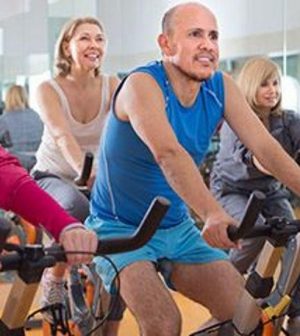- Navigating Your Midlife Crisis: Embracing New Possibilities
- City Raccoons Showing Signs of Domestication
- Mapping the Exposome: Science Broadens Focus to Environmental Disease Triggers
- One Week Less on Social Media Linked to Better Mental Health
- Your Brain Changes in Stages as You Age, Study Finds
- Some Suicide Victims Show No Typical Warning Signs, Study Finds
- ByHeart Formula Faces Lawsuits After Babies Sickened With Botulism
- Switch to Vegan Diet Could Cut Your Greenhouse Gas Emissions in Half
- Regular Bedtime Does Wonders for Blood Pressure
- Dining Alone Could Mean Worse Nutrition for Seniors
Want to Avoid Sleep Apnea? Get Off the Sofa

Here’s yet another reason to limit screen time and get moving: Boosting your activity levels could reduce your risk of sleep apnea, according to a new study.
Compared to the most active people in the study, those who spent more than four hours a day sitting watching TV had a 78% higher risk of obstructive sleep apnea (OSA), and those with sedentary jobs had a 49% higher risk.
And that added risk was not due to their weight.
“We saw a clear relationship between levels of physical activity, sedentary behavior and OSA risk. People who followed the current World Health Organization physical activity guidelines of getting at least 150 minutes of moderate activity per week, and who spent less than four hours per day sitting watching TV, had substantially lower OSA risk,” said study leader Tianyi Huang, an assistant professor and associate epidemiologist at Brigham and Women’s Hospital and Harvard Medical School, in Boston.
People with this disorder stop and start breathing many times during sleep. Common symptoms include snoring, disrupted sleep and excessive tiredness. Poorly managed sleep apnea can increase the risk of high blood pressure, stroke, heart attack, irregular heartbeat and type 2 diabetes.
After accounting for risk factors such as obesity, age, smoking and drinking, the researchers found that people whose activity levels were equivalent to three hours of running a week had a 54% lower risk of sleep apnea than those whose activity levels were equivalent to two hours a week of walking at an average pace.
The study included more than 138,000 U.S. women and men without a diagnosis of sleep apnea. They were followed for 10 to 18 years. Over that time, more than 8,700 were diagnosed with the condition.
So are desk jockeys doomed? Not necessarily.
The researchers said folks with sedentary jobs could lower their risk by getting more exercise in their leisure time. Also, those who can’t do much physical activity due to physical limitations could lower their risk of sleep apnea by standing or doing other gentle activities more often.
The study was published July 20 in the European Respiratory Journal.
“Importantly, we saw that any additional increase in physical activity, and/or a reduction in sedentary hours, could have benefits that reduce the risk of developing OSA,” Huang explained in a journal news release.
The difference in risk between sedentary work and time spent sitting watching TV could be explained by other behaviors related to those activities, the researchers suggested.
“For example, snacking and drinking sugary drinks is more likely to go along with watching TV compared with being sedentary at work or elsewhere, such as sitting during traveling. This could lead to additional weight gain, which we know to be a risk factor for OSA,” Huang noted.
It’s estimated that 1 billion adults worldwide, aged 30 to 69, have mild to severe sleep apnea.
Anita Simonds, president of the European Respiratory Society, was not involved with the study but commented on the report. She said, “It is encouraging that even a small increase in physical activity or reduction in sedentary hours could reap potential benefits. It is therefore an important message to get across to our patients and their families in primary care and respiratory clinics.”
More information
The U.S. National Heart, Lung, and Blood Institute has more on sleep apnea.
SOURCE: European Respiratory Journal, news release, July 20, 2021
Source: HealthDay
Copyright © 2025 HealthDay. All rights reserved.










